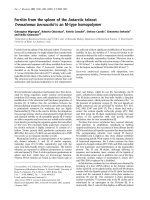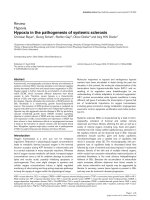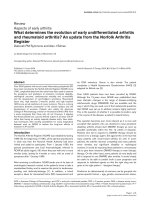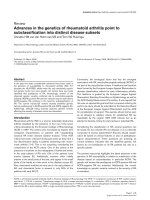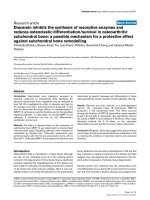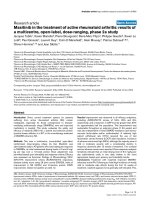Báo cáo y học: " Pitfalls with the “chest compression-only” approach: the challenge of an unusual cause" pptx
Bạn đang xem bản rút gọn của tài liệu. Xem và tải ngay bản đầy đủ của tài liệu tại đây (195.6 KB, 3 trang )
CAS E RE P O R T Open Access
Pitfalls with the “chest compression-only”
approach: the challenge of an unusual cause
Bjørn Ole Reid
1*
, Eirik Skogvoll
1,2,3
Abstract
Chest compression-only (CC-only) is now incorporated in the Norwegian protocol for dispatch guided CPR (cardio-
pulmonary resuscitation) in cardiac arrest of presumed cardiac aetiology.
We present a case that is unique and instructive as well as unusual. It reminds us of the challenges that face
bystanders, dispatch centres and ambulance services when faced with possible cardiac arrest.
This case report describes a 50 year old man in a rural community. He had suffered a heart attack 8 months pre-
viously, and was found unconscious with respiratory arrest in his garden one morning. Due to the proximity to the
ambulance station, the paramedics were on the scene within three minutes. A chain-saw was lying beside him, but
no external injuries were seen. The patient had no radial pulse, central cyanosis and respiratory gasps approxi-
mately every 30 seconds. Ventilation with bag and mask was given, and soon a femoral pulse could be palpated.
Blood sugar was elevated and ECG (electrocardiogram) was normal. GCS (Glasgow Coma Scale) was 3. Upon arrival
of the physician staffed air ambulance, further examination revealed bilateral miosis of the pupils and continuing
bradypnoea. Naloxone was given with an immediate effect and the patient woke up. The patient denied intake of
narcotics, but additional information from the dispatch centre revealed that he was hepatitis C positive.
After a few hours, the patient admitted to have obtained a fentanyl transdermal patch from an acquaintance, hav-
ing chewed it before falling unconscious.
This case report shows the importance as well as the challenges of identifying a non-cardiac cause of possible car-
diac arrest, and the value of providing causal therapy.
Introduction
Since 2009, chest compression-only (CC-only) CPR is
incorporated in the Norwegian protocol for dispatch
CPR for cardiac arrest of presumed cardiac aetiology
[1]. This is in accordance with recommendations from
the Norwegian Resuscitation Council (.
org/wp-content/uploads/200 9/12/NRR-om-brystkom-
presjoner-alene.pdf, accessed 17.06.2010). A case report
illustrating the success of this approach has recently
been published [2]; moreover equal efficacy of CC-only
CPR compared to traditional CPR in which chest com-
pressions are interspersed with ventilations has been
shown [3], although this may not be the case in children
[4]. While defaulti ng to CC-only CPR, the new dispatch
protocol nevertheless presupposes that patients with a
likely hypoxic cause of their cardiac arrest should
receive standard CPR with ventilations. Drowning, stran-
gulation and drug overdose are highlighted as reasons
for suspecting hypoxia as the cause of the arrest [1].
This presupposition clearly puts a great challenge on the
dispatchers to correctly identify the aetiology.
The present case report is based on interviews with
the Emergency Medical System (EMS) personnel
involved, the ambulance-/air ambulance case reports,
and documentation from the emergency dispatch centre.
The patient has given written consent to the publication.
We believe it is unique and instructive as well as unu-
sual; reminding us of the challenges that face bystan-
ders, dispatch centres and a mbulance services when
faced with possible cardiac arrest.
Case presentation
A 50 year old man living in a rural community was one
morning found in his garden unconscious and in
respiratory arrest. The local ambulance station was only
100 metres away, thus paramedics were on scene within
* Correspondence:
1
Dept. of Anaesthesiology and Emergency Medicine, St. Olav University
Hospital, N-7006 Trondheim, Norway
Full list of author information is available at the end of the article
Reid and Skogvoll Scandinavian Journal of Trauma, Resuscitation and Emergency Medicine 2010, 18:45
/>© 2010 Reid and Skogvoll; licensee BioMed Central Ltd. This is an Open Acce ss article distributed under the terms of the Creative
Commons Attribution License ( , which permits unrestricted use, distribution, and
reproduction in any medium, provide d the original work is properly cited.
three minutes. The patient was found unconscious, with
Glasgow Coma Scale (GCS) 3, central cyanosis, no palp-
able radial pulse, and respiratory gasps approximately
every 30 seconds. He was lying next to an electric chain
saw, but no external injuries were seen. When applied,
the AED (automated external defibrillator) showed a
sinus rhythm with a frequenc y of 65/minute. The emer-
gency dispatch centre was alerted, and a provisional
diagnosis of cardiac arrest with pulseless electrical activ-
ity (PEA) was made. The general practitioner (GP) on
call and the physician staffed air ambulance were
alerted.
The dispatch central obtained and conveyed further
medical information to personnel on scene: the patient
suffered from insulin dependent diabetes mellitus, and
had recently (8 months previously) suffered a heart
attack which led to a percutaneous coronary interven-
tion (PCI) procedure. Chest compressions were n ot
initiated by the paramedics, however; they provided ven-
tilation with bag and mask and oxygen. After approxi-
mately two minut es, a femoral pulse could be palpated.
Blood glucose was 22 mmol/L. An ECG was recorded
and transmitted via cell phone for evaluation by a cardi-
ologist, who concluded that there w as no evidence of
acute cardiac pathology.
Upon arrival of the air ambulance 23 minutes after the
alarm, GCS was 3, non invasive blood pressure was 140/
70 mmHg, pulse 70/minute (sinus), oxygen saturation
91%, and respiratory frequency 5/minute. A Guedel tube
secured the airway. Both pupils were “pin size” with no
deviation. Having received a dditional informat ion, the
dispatch central now informed personnel on sce ne that
the pat ient was positive for hepatitis C. Suspecting
opioid overdose, Narcanti® (naloxone hydrochloride) 0.4
mg was administe red i.v. (with an additio nal i.m. dose),
upon which the patient wit hin a minute was awake and
sat up. He was at this stage confused and could not
remember what had happened. He denied chest pain,
headache, nausea or breathlessness; as well as intake of
any substances. Now the medical history became more
complete, and details of substantial drug abuse some
twenty years earlier emerged. Three hours later he
admitted to having obtained a Durogesic® (fentanyl)
transdermal patch (75 u g/hour) from an acquaintance
the previous day. He had applied it to his skin during
the night, but it had fallen off. In the morning he had
gone outside to do some work in the garden, had
chewed it, suddenly felt very dizzy and became uncon-
scious. The paramedics could then recall removing what
they thought was chewing gum from his mouth before
administering bag-mask ventilations. The patient made
an unremarkable recovery.
Discussion
This case is unusual in sever al ways. The alerting of the
paramedics was quite unorthodox in that they were con-
tacted directly by bystanders and not via the dispatch
centre, which is the standard. Therefore, in this instance,
the paramedics themselves were the first to initiate con-
tact with the dispatch centre and define the need for
further assistance.
The mode of overdose is also unusual, and we find it
important to raise the awareness of the possible abuse
of the transdermal patch. Literature reports show that
there have been several fatalities in both adults and chil-
dren following ingestion, smoking or administration via
intravenous route [5,6]. The clinical pharmacokinetics of
transdermal opioids are also described [7].
This case of an opioid overdose causing unconscious-
ness, extreme bradypnoea with hypoxia and hypotension
without pulse, is in effect a case of PEA. The context
could very easily lead one to wrongly infer a cardiac
cause, and not an overdose. The rural setting, age of the
patient and recent medical history all pointed in that
direction. The electric chain saw lying by the patient
could have caused further confusion as to the cause of
unconsciousness; trauma and electrocution had to be
ruled out. Hypoglycemia might also have been the cause
of unconsciousness.
Although the dispatch centre was informed that this
was a cardiac arrest, no chest compressions were given,
only ventilations. The paramedics explained that the
reason for this was because the patient still had respira-
tory gasps. We believe that differentiating betwee n ago -
nal respirations and severe bradypnoea is difficult, and
that such a setting where no pulse could be felt should
often lead to the initiation of chest compressions.
However, effective ventilations in this case reversed
the hypoxia and increased cardiac output to a satisfac-
tory level. Unconsciousness was reversed with an anti-
dote. The question must be raised as to whether the
satisfactory outcome would have been obtained if the
patient had not received such prompt effective ventila-
tions. Under usual circumstances with a longer prehos-
pital response time, it is very likely that it would have
been interpreted as an arrest of a primary cardiac cause.
The protocol for dispatch guided CPR would advise
compressions-only for bystanders. In an already ser-
iously hypoxic p atient, compressions-only would prob-
ably have been of little benefit to the patient.
The beauty of traditional CPR is th at the combina tion
of compressions and ventilations will cover most poten-
tially reversible causes of cardiac arrest. Whether the
simplification that follows from defaulting to CC-only
really is beneficial, remains to be seen.
Reid and Skogvoll Scandinavian Journal of Trauma, Resuscitation and Emergency Medicine 2010, 18:45
/>Page 2 of 3
In conclusion, prehospital cardiac arrest poses a sub-
stantial challenge for bystanders, dispatch centres and
EMS personnel. With new protocols that assume a car-
diac cause by default, a high grade of awareness and
suspicion is necessary. Collection and sharing of relevant
clinical details, history and information is crucial.
Author details
1
Dept. of Anaesthesiology and Emergency Medicine , St. Olav University
Hospital, N-7006 Trondheim, Norway.
2
Norwegian University of Science and
Technology (NTNU), Faculty of Medicine, Institute of Circulation and Medical
Imaging, P.O. Box 8905 MTFS, N-7491 Trondheim, Norway.
3
Norwegian Air
Ambulance Foundation, P.O. Box 94, N-1441 Drøbak.
Authors’ contributions
BOR drafted the manuscript. ES made substantial revisions. Both authors
have revised, read and approved the article.
Competing interests
The authors declare that they have no competing interests.
Received: 18 June 2010 Accepted: 13 August 2010
Published: 13 August 2010
References
1. The Norwegian Medical Association: The Norwegian Index to emergency
medical assistance Stavanger: The Laerdal Foundation for Acute Medicine, 3
2009.
2. Steen-Hansen JE: Favourable outcome after 26 minutes of “Compression
only” resuscitation. Scandinavian Journal of Trauma, Resuscitation and
Emergency Medicine 2010, 18:19.
3. SOS-KANTO group: Cardiopulmonary resuscitation by bystanders with
chest compression only (SOS-KANTO): an observational study. Lancet
2007, 369(9565):920-6.
4. Kitamura T, Iwami T, Kawamura T, Nagao K, Tanaka H, Nadkarni VM,
Berg RA, Hiraide A, implementation working group for All-Japan Utstein
Registry of the Fire and Disaster Management Agency: Conventional and
chest-compression-only cardiopulmonary resuscitation by bystanders for
children who have out-of-hospital cardiac arrests: a prospective,
nationwide, population-based cohort study. The Lancet 2010,
375(9723):1347-54.
5. Teske J, Weller JP, Larsch K, Troger HD, Karst M: Fatal outcome in a child
after ingestion of a transdermal fentanyl patch. Int J Legal Med 2007,
121(2):147-51.
6. Oechsler S, Zimmer G, Pedal I, Skopp G: Has the transdermal patch gone
up in smoke? A fatal fentanyl intoxication. Arch Kriminol 2009, 224(1-
2):26-35.
7. Grond S, Radbruch L, Lehmann KA: Clinical pharmacokinetics of
transdermal opioids: focus on transdermal fentanyl. Clin Pharmacokinet
2000, 38(1):59-89.
doi:10.1186/1757-7241-18-45
Cite this article as: Reid and Skogvoll: Pitfalls with the “chest
compression-only” approach: the challenge of an unusual cause.
Scandinavian Journal of Trauma, Resuscitation and Emergency Medicine 2010
18:45.
Submit your next manuscript to BioMed Central
and take full advantage of:
• Convenient online submission
• Thorough peer review
• No space constraints or color figure charges
• Immediate publication on acceptance
• Inclusion in PubMed, CAS, Scopus and Google Scholar
• Research which is freely available for redistribution
Submit your manuscript at
www.biomedcentral.com/submit
Reid and Skogvoll Scandinavian Journal of Trauma, Resuscitation and Emergency Medicine 2010, 18:45
/>Page 3 of 3
